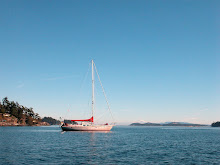St Kilda
first came to our attention when Krystina saw the book The Life and Death of St Kilda by Tom Steel in the Iona Heritage
Centre’s gift shop. Until then St Kilda had meant nothing more to us than a
lump of rocks on the chart. From the brief summary on the back of the book
those rocks were transformed to remote islands where a special community lived
for over 2,000 years until they made the difficult decision to evacuated the
island in 1930. Today St Kilda is the UK’s only UNESCO Dual World Heritage Site
and remains accessible only by boat in calm conditions. Though the book peeked
Krystina’s interest, St Kilda wasn’t on Snow Dragon’s itinerary and she put the
book back on the shelf and continued to explore Iona.
Staffa
Back on board the story of the community continued to intrigue her. After a magical stop on Staffa, an uninhabited island also only accessible by boat, she decided to mention the idea of going to St Kilda to Frances. The archipelago required an 80-mile detour, a real commitment of time. It would only be realistic if the weather was favorable to safely stop at St Kilda’s minimally protected anchorage and then continue directly to the Faroe Islands. We agreed to shorten our time in Skye and skip stopping anywhere else in the Outer Hebrides if the conditions where right to attempt a visit to St Kilda but it seemed unlikely the Scottish weather would cooperate.
In Skye we got a second chance to purchase
a copy of The Life and Death of St Kilda.
Reading the book only intensified our fascination with the history of the area.
The people who lived on the island were united in their daily struggle to survive
in a desolate place where food was scarce and help could only be found amongst other
members of the community. With no transport, no supplies and no medical
treatment, their only link to the outside world were occasional shipwreck
survivors, Victorian tourists and the factor’s annual visit. By 1930 the
population that once numbered up to 200 had been reduced to 36 by disease and emigration.
With no chance of outside aid to fund a doctor or a ferry to the mainland, the
community finally gave into government pressure and agreed to evacuate the
island. Sadly their way of life and community was lost once they boarded the
ship for the mainland where they were resettled away from each other and forced
to adjust to a world were money was needed to survive.
The
weather report showed southeasterly wind, the right conditions for sailing to
the Faroe Islands but completely wrong for stopping at St Kilda. However, the
wind was supposed to be remain light for 36 hours before increasing and we
decided to take the chance and risk only being able to sail past the
archipelago.




No comments:
Post a Comment